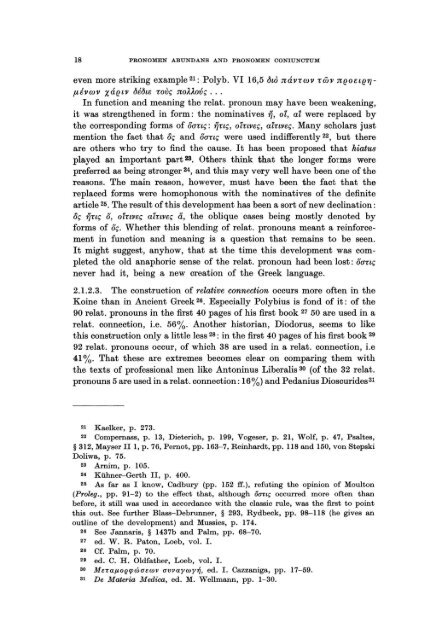Pronomen Abundans and Pronomen Coniunctum. A ... - DWC
Pronomen Abundans and Pronomen Coniunctum. A ... - DWC
Pronomen Abundans and Pronomen Coniunctum. A ... - DWC
You also want an ePaper? Increase the reach of your titles
YUMPU automatically turns print PDFs into web optimized ePapers that Google loves.
18 PRONOMEN ABUNDANS AND PRONOMEN CONIUNCTUM<br />
even more striking example 21 : Polyb. VI 16,5 bul náv-rw" -rw" n(!oet(!'YJ<br />
",é"w" Xá(!t" bébte -rovç noAÄoVç . ..<br />
In function <strong>and</strong> meaning the relat. pronoun may have been weakening,<br />
it was strengthened in form: the nominatives ij, ol, ar were replaced by<br />
the corresponding forms of aauç: ijuç, olu"eç, al-rweç. Many scholars just<br />
mention the fact that oç <strong>and</strong> aauç were used indifferently 22, but there<br />
are others who try to find the cause. It has been proposed that hiatu8<br />
played an important part 28. Others think that the longer forms were<br />
preferred as being stronger 24, <strong>and</strong> this may very weU have been one of the<br />
reasons. The main reason, however, must have been the fact that the<br />
replaced forms were homophonous with the nominatives of the definite<br />
article 25. The result of this development has been a sort of new declination :<br />
oç ijuç a, olu"eç alu"eç ä, the oblique cases being mostly denoted by<br />
forms of aç. Whether this blending of relat. pronouns meant a reinforcement<br />
in function <strong>and</strong> meaning is a question that remains to be seen.<br />
It might suggest, anyhow, that at the time this development was completed<br />
the old anaphoric sense of the relat. pronoun had been lost: aauç<br />
never had it, being a new creation of the Greek language.<br />
2.l.2.3. The construction of relative connection occurs more of ten in the<br />
Koine than in Ancient Greek 26. Especially Polybius is fond of it: of the<br />
90 relat. pronouns in the first 40 pages of his fust book 27 50 are used in a<br />
relat. connection, i.e. 56%. Another historian, Diodorus, seems to like<br />
this construction only a little less 28: in the first 40 pages of his fust book 29<br />
92 relat. pronouns occur, of which 38 are used in arelat. connection, i.e<br />
41 %. That these are extremes becomes clear on comparing them with<br />
the texts of professional men like Antoninus Liberalis 30 (of the 32 relat.<br />
pronouns 5 are used in arelat. connection : 16%) <strong>and</strong> Pedanius Dioscurides 31<br />
21 Kaelker, p . 273.<br />
22 Compernass, p. 13, Dieterich, p. 199, Vogeser, p. 21, Wolf, p. 47, Psaltes,<br />
§ 312, Mayser II 1, p. 76, Pernot, pp. 163- 7, Reinhardt, pp. U8 <strong>and</strong> 150, von Stepski<br />
Doliwa, p. 75.<br />
23 Arnim, p. 105.<br />
24 Kühner-Gerth II, p. 400.<br />
25 As far as I know, Cadbury (pp. 152 ff.), refuting the opinion of Moulton<br />
(Proleg., pp. 91-2) to the effect that, although ÖC1TIÇ occurred more of ten than<br />
before, it still was used in accordance with the classic rule, was the fust to point<br />
this out. See further Blass-Debrunner, § 293, Rydbeck, pp. 98-118 (he gives an<br />
outline of the development) <strong>and</strong> Mussies, p. 174.<br />
26 See Jannaris, § 1437b <strong>and</strong> Palm, pp. 68-70.<br />
27 ed. W. R. Paton, Loeb, vol. I.<br />
28 Cf. Palm, p. 70.<br />
29 ed. C. H. Oldfather, Loeb, vol. I.<br />
30 Me-capoecpwaewv avvaywY7/, ed. I. Cazzaniga, pp. 17-59.<br />
31 De Materia Medica, ed. M. Wellmann, pp. 1-30.
















